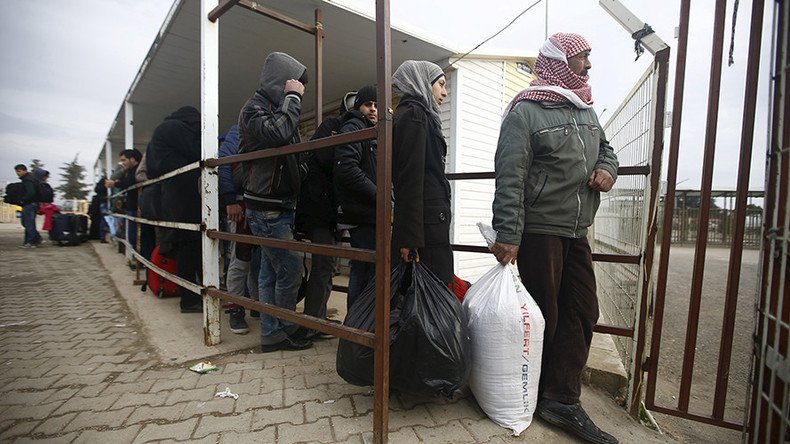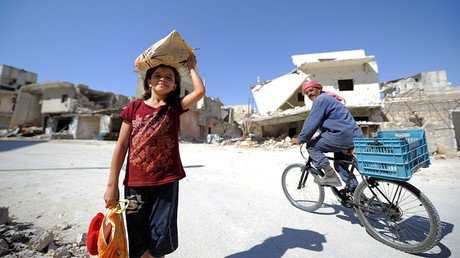40,000+ Syrian refugees head home from Turkey to celebrate feast of sacrifice

Thousands of Syrians refugees are returning home from Turkey just in time to celebrate a major Muslim holiday amid significantly improved security, provided to a great extent by the Russian military and the reconciliation efforts within the de-escalation zones.
At the start of the year, Syria's President Bashar Assad estimated that some 4.8 million Syrian refugees have fled the country during the ongoing civil war. Turkey has welcomed almost three million Syrians since the conflict broke out in 2011.
For the past two weeks, those who have been displaced have been taking advantage of the newly created stability in Syria to return home to visit loved ones in time for Kurban Bayram (Feast of the Sacrifice, also known as Eid al-Adha) celebrations which begin on August 31.
On August 15, Turkish authorities in the Kilis governorate opened the Oncupınar gate border crossing, allowing thousands of refugees to temporarily or permanently reunite with their families in Syria. They have registered and uploaded their details on a specially created website and those who opt to return to Turkey will have until October 15 to do so.
Ahead of Friday’s festival, which commemorates the willingness of Ibrahim, the Biblical Abraham, to sacrifice his son Ismael as an act of obedience to God, at least 44,000 refugees crossed into Syria, Turkey's Daily Sabah reported.
Syrians living in Turkey are heading to Al-Bab and Jarabulus, towns cleared of terrorists during Turkey’s Euphrates Shield cross-border military operation which concluded earlier this year. Others are headed to regions now covered by the de-escalation zones.
The proposal to establish four de-escalation zones was signed by Russia, Iran and Turkey, with the approval of the Syrian government in the Kazakh capital, Astana in May. The UN has welcomed the initiative. All four designated zones are areas controlled by armed rebels who have been under pressure from the government forces’ advance.
Under the terms of the ceasefire agreement, they are to be monitored by the Astana signatories, while Russia retains the right to control the airspace above them, without engaging in air raids. Islamic State (IS, formerly ISIS/ISIL) and Jabhat al-Nusra linked terrorist cells are not included in the ceasefire agreement.
Syria de-escalation zones: Russia deploys military police in E. Ghouta, Idlib talks ‘ongoing’ https://t.co/bDMpGR7PCz
— RT (@RT_com) July 24, 2017
Those regions which have laid down their arms are now living in relative peace, just a dream just months ago. Russian military police control the implementation of the agreement on the ground, while a Russia-Turkey Commission is charged with registering violations in the de-escalation zones.
Last rebel group in #Syria’s East Ghouta de-escalation zone joins truce – Russian MoD https://t.co/iR2uTZH3bXpic.twitter.com/pLDCh7aI6A
— RT (@RT_com) August 19, 2017
In the first seven months of this year, over 600,000 displaced Syrians returned home, the International Organization for Migration (IOM) said earlier this month.
Russia’s Defense Minister, Sergey Shoigu, expressed hope that international organizations will assist in the return of civilians to Syria. “Today we say: ‘Send [the aid] to the de-escalation zones, everything is open there. If you cannot transport, we shall transport for you,'” Shoigu was quoted as saying by TASS earlier this month.
'May God make us free of ISIS': Life continues in Deir ez-Zor as locals struggle on front line with terrorists https://t.co/n6NF0pAhDPpic.twitter.com/mDpE0lC0MR
— RT (@RT_com) August 17, 2017
“Further on, refugees would return home, at first from inside Syria, what is happening already now, and then from other regions,” he added.
Russia's defense ministry meanwhile continues its efforts of reconciling opposing sides in Syria. As of Tuesday, some 214 localities in Syria have signed the reconciliation agreement.
ISIS moves heavy weapons to Deir ez-Zor to protect its ‘last stronghold’ in Syria – Russian MOD https://t.co/ZRkZkyKtV3
— RT (@RT_com) August 28, 2017
“Negotiations on joining ceasefire regime have continued with field commanders of detachments of the armed opposition in the Aleppo, Damascus, Homs, Hama, Idlib and al-Quneitra provinces,” the ministry said, adding that 229 armed formations are now observing the ceasefire regime in the country.
Furthermore, Russia hopes that Islamic State militants will soon be driven out of Syria, as over 8,000 terrorists were killed in Syria over the past three months alone, Commander of the Russian forces in Syria, Colonel-General Sergey Surovikin said Friday.
However, the Chief of the Main Intelligence Directorate (GRU) of the Russian Federation said that over 9,000 terrorist fighters are still active in Syria. “More than 9,000 militants, who are now concentrated mainly in the central part of the country and the republic’s eastern areas bordering Iraq, mainly along the Euphrates River,” are now fighting in Syria, Igor Korobov, said Thursday.
'The defeat of #ISIS in the #DeirEzZor region will be a strategic defeat for the terrorist group in Syria' – MoD https://t.co/qx9XE8tNns
— RT (@RT_com) August 21, 2017
Effective operations by Russia’s air force have propelled the Syrian army's advance along the eastern bank of the Euphrates towards Deiz ez-Zor, the defense ministry said Monday. Islamic State terrorists have been moving tanks and other heavy weaponry to the Deir ez-Zor area in a desperate attempt to hold their positions in the region following the successful offensive of the Syrian Army, the ministry noted.
Russian forces target large column of #ISIS terrorists heading to Deir ez-Zor, Syria – MoD https://t.co/MTiKNcltU5pic.twitter.com/Ln3NIlICGx
— RT (@RT_com) August 21, 2017
The key Euphrates city of Deir ez-Zor has been under terrorist siege for years. The surrounded city, alongside a neighboring military base and airfield, were supplied with food and ammunition by Russian and Syrian transport planes and helicopters. Earlier this month, Shoigu noted that the fall of IS in Deir ez-Zor might signal the end of the jihadist organization.













